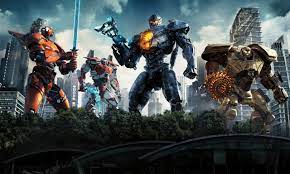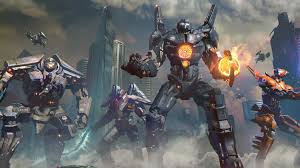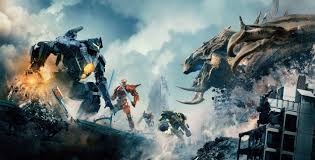🎬 Pacific Rim: Uprising (2018)

Pacific Rim: Uprising (2018) Review
Introduction
Released in 2018, Pacific Rim: Uprising is the sequel to Guillermo del Toro’s 2013 blockbuster Pacific Rim. Directed by Steven S. DeKnight, the film shifts its focus to a new generation of Jaeger pilots tasked with defending Earth against a renewed kaiju threat. With its high-octane action and an expanded lore, the movie aims to capture the imagination of both old fans and new audiences. Does it succeed in delivering a worthy follow-up? Let’s break it down in this comprehensive review.
Plot Overview
Set ten years after the events of the first film, Pacific Rim: Uprising introduces Jake Pentecost (John Boyega), the estranged son of legendary Jaeger pilot Stacker Pentecost. Once a promising pilot himself, Jake has since abandoned his military roots and turned to a life of petty crime. However, when a new kaiju threat emerges, Jake is forced to step back into the fray, teaming up with his estranged sister Mako Mori (Rinko Kikuchi) and a young prodigy, Amara Namani (Cailee Spaeny).
The movie explores the rise of a new wave of Jaeger pilots, the mysterious origins of the kaiju resurgence, and a sinister conspiracy involving rogue Jaeger technology. Packed with colossal battles and jaw-dropping visuals, the film culminates in an epic showdown in Tokyo.
Strengths
1. Visually Stunning Action
The hallmark of the Pacific Rim franchise is its larger-than-life battles between Jaegers and kaiju, and Uprising delivers on this front. The action sequences are crisp, dynamic, and inventive, showcasing upgraded Jaeger technology and kaiju mutations. The climactic battle in Tokyo is particularly memorable, with skyscraper-sized destruction and breathtaking choreography.
2. John Boyega’s Charisma
As the film’s lead, John Boyega brings charm and energy to his role. Jake Pentecost is a far cry from his father’s stoic demeanor, offering a more relatable, humorous, and rebellious protagonist. Boyega’s performance adds a fresh layer to the franchise and anchors the narrative.
3. Focus on a New Generation
The introduction of younger characters, especially Amara Namani, injects youthful energy into the story. Amara’s journey from a scrappy, self-taught engineer to a skilled pilot is one of the more engaging arcs in the film. Her bond with Jake adds emotional depth to the otherwise action-heavy plot.
4. Expanded Universe
The sequel builds on the lore established in the original film, exploring the evolution of Jaeger technology and the potential for human-kaiju hybrids. This expansion opens the door for future stories and adds complexity to the franchise’s world-building.
Weaknesses
1. Lack of Emotional Resonance
One of the strengths of the original Pacific Rim was its emotional core, driven by the bond between Raleigh Beckett and Mako Mori. In contrast, Uprising struggles to establish similarly compelling relationships. While the new characters are likable, their connections feel underdeveloped.
2. Predictable Plot
The film’s narrative is straightforward and often predictable. Twists, such as the reveal of a rogue Jaeger’s true origins, lack the impact needed to keep the audience on edge. As a result, the story occasionally feels more like a vehicle for action sequences than a cohesive narrative.
3. Villain Underutilization
The primary antagonists, including the rogue Jaeger Obsidian Fury and the kaiju themselves, are visually impressive but lack depth. The human villain subplot, while intriguing, is underexplored and fails to provide a memorable foil for the protagonists.
4. Shadows of the Original
Without Guillermo del Toro at the helm, Uprising lacks the sense of awe and wonder that defined the first film. The movie leans heavily into a more mainstream blockbuster tone, sacrificing some of the originality and artistry that made Pacific Rim stand out.
Themes and Symbolism
1. Redemption and Legacy
Jake Pentecost’s journey is rooted in the themes of redemption and living up to a legacy. His arc explores the pressures of following in the footsteps of a larger-than-life parent and finding his own path.
2. Unity Through Diversity
As with the first film, Uprising emphasizes the power of collaboration across cultures and backgrounds. The international team of Jaeger pilots represents a hopeful vision of humanity working together to overcome challenges.
3. The Cost of Progress
The film critiques the blind pursuit of technological advancement without considering its consequences. The rogue Jaeger subplot highlights how innovation can be weaponized, raising ethical questions about its use.
Visual and Technical Aspects
1. Special Effects
The visual effects in Uprising are top-notch, with intricate Jaeger designs and highly detailed kaiju. The battles are dynamic and make excellent use of scale, immersing viewers in the chaos.
2. Sound Design
The sound design complements the larger-than-life visuals, with booming Jaeger footsteps and kaiju roars adding to the immersive experience. The score, while serviceable, lacks the memorable themes of the original.
3. Set Design
From sprawling cityscapes to high-tech Jaeger bases, the film’s production design creates a vibrant and believable world. The use of Tokyo as the climactic battleground is particularly striking.
Final Verdict
Pacific Rim: Uprising is an entertaining sequel that delivers on action and spectacle but falls short in emotional depth and narrative complexity. While it expands the franchise’s universe and introduces a charismatic new lead, it struggles to recapture the magic of the original. For fans of giant robots and monster battles, it’s a fun ride—just don’t expect it to leave a lasting impression.
Rating: 6.5/10